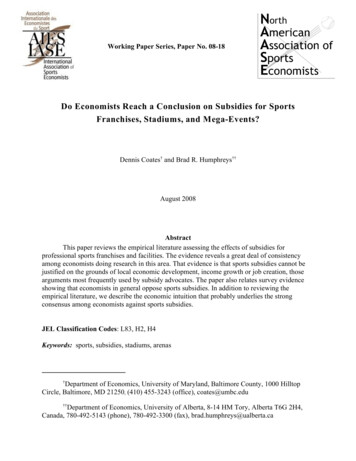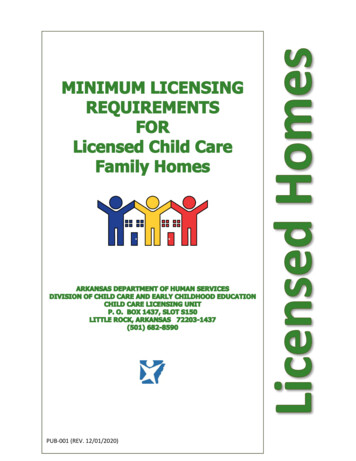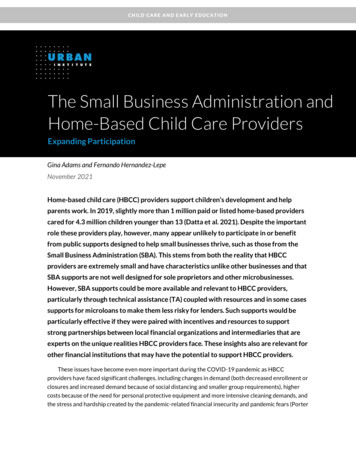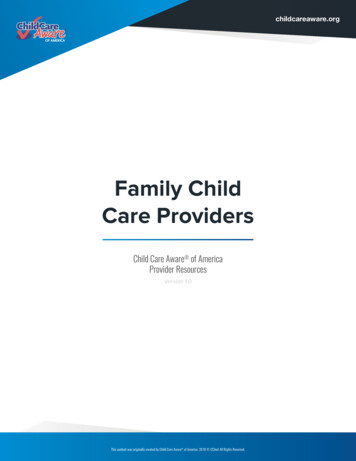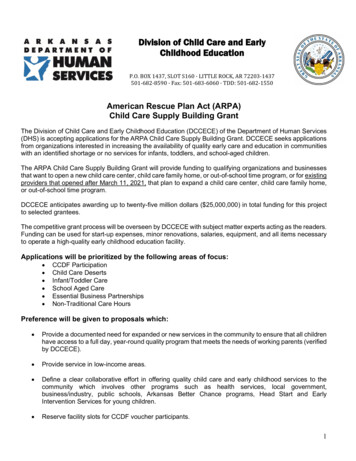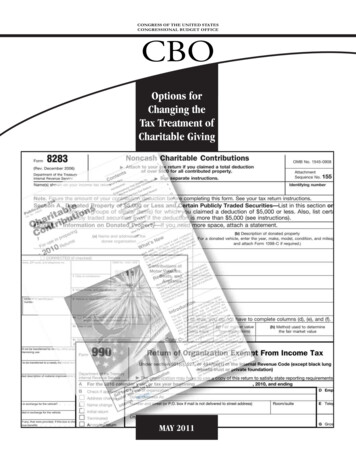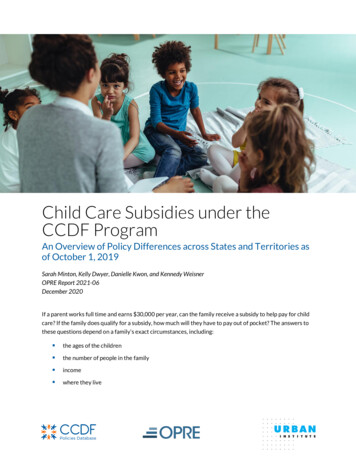
Transcription
Child Care Subsidies under theCCDF ProgramAn Overview of Policy Differences across States and Territories asof October 1, 2019Sarah Minton, Kelly Dwyer, Danielle Kwon, and Kennedy WeisnerOPRE Report 2021-06December 2020If a parent works full time and earns 30,000 per year, can the family receive a subsidy to help pay for childcare? If the family does qualify for a subsidy, how much will they have to pay out of pocket? The answers tothese questions depend on a family’s exact circumstances, including: the ages of the children the number of people in the family income where they live
Child care subsidies are provided through a federal block grant program called the Child Care andDevelopment Fund (CCDF). CCDF provides funding to the States, Territories, and Tribes. They use themoney to administer child care subsidy programs for low-income working families.1In setting up their CCDF programs, States/Territories must comply with federal guidelines,2 including (butnot limited to): establishing income eligibility limits at or below 85 percent of state median income (SMI) setting the maximum age for children receiving a subsidy at under 13 years of age, or under age 19 ifchildren have special needs defining the activities that qualify a family for assistance, within the federally-allowed categories(employment, education, etc.)States/Territories also have the discretion to establish many other detailed policies used to operate theirCCDF programs. In this brief, we present some of the policy differences across the States and Territories.The policies are taken from the CCDF Policies Database, a project funded by the Office of Planning,Research, and Evaluation within the Administration for Children and Families. 3 The CCDF Policies Databasetracks State/Territory policies over time, with hundreds of variables describing policies related to: family eligibility application and waiting list procedures family copayments provider reimbursement rates other provider policiesThis brief serves as a companion piece to the report “Key Cross-State Variations in CCDF Policies as ofOctober 1, 2019”, providing a graphical overview of some of the policy differences acrossStates/Territories.4 Each year, State/Territory administrators and program staff are asked to review andverify the data in the report. Some States/Territories were not able to complete the review this year,particularly in light of the review process falling at the same time as the COVID-19 pandemic. For moreinformation on which States/Territories were able to review the data, see table I.B in the full report.1In addition to providing subsidies for working families, CCDF may also support parents in education and trainingprograms as well as parents looking for employment.2 “States/Territories” is used throughout the brief to refer to the 50 States, the District of Columbia, American Samoa(AS), the Commonwealth of the Northern Mariana Islands (MP), Guam (GU), Puerto Rico (PR), and the Virgin Islands (VI).The CCDF Policies Database and this brief focus on State/Territory CCDF policies and do not cover Tribal CCDFpolicies.3 The data are available for public use through annual published reports and access to the full Database detail.4 For the 2019 Key Cross-State Variations report, see: Dwyer, Kelly, Sarah Minton, Danielle Kwon, and KennedyWeisner (2020). Key Cross-State Variations in CCDF Policies as of October 1, 2019: The CCDF Policies Database Bookof Tables. OPRE Report 2021-07, Washington, DC: Office of Planning, Research, and Evaluation, Administration forChildren and Families, U.S. Department of Health and Human Services.2CHILD CARE SUBSIDIES UNDER THE CCDF PROGRAM
We describe and present policies related to: eligibility requirements family application and terms of authorization family payments policies for providersFinally, we provide information about additional resources that are available from the CCDF PoliciesDatabase project.Eligibility Requirements for Families and ChildrenAs described above, families must meet certain eligibility criteria to qualify for child care subsidies under theCCDF program. Within the federal guidelines, States/Territories establish exactly which activities theyapprove for CCDF-funded child care. Additionally, in almost all cases, families must have incomes below thethreshold defined by the State/Territory to be eligible for the child care subsidy.What Activities Does Each State/Territory Approve for CCDF Eligibility?To qualify for subsidies, parents and guardians typically must participate in approved activities, as definedby each State/Territory. Employment is an approved activity in every State/Territory, and manyStates/Territories also approve child care subsidies for parents participating in education and trainingactivities. Figure 1 shows which States/Territories approve each of these activities: High school (54 States/Territories) GED activities (52 States/Territories) Post-secondary education (45 States/Territories) English as a Second Language activities (31 States/Territories) Training (49 States/Territories) Adult basic education (36 States/Territories)CHILD CARE SUBSIDIES UNDER THE CCDF PROGRAM3
Figure 1State/Territory Approved Education and Training Activities for Eligibility (2019)54AL52AK49This block graph shows whether the 56 US states, territories, and outlying areas allow high school, GED, post-secondary education, ESL, training, or ABE as an eligible activity in their CCDF programs. As of October 1, 2019, 54 states and territories allow high school as an eligible activity: Alabama,Alaska, American Samoa, Arizona, Arkansas, California, Colorado, Connecticut, District of Columbia, Delaware, Florida, Georgia, Guam, Hawaii, Idaho, Illinois, Indiana, Iowa, Kansas, Kentucky, Louisiana, Maine, Northern Mariana Islands, Maryland, Massachusetts, Michigan, Minnesota, Mississippi,Missouri, Montana, Nebraska,ASNevada,AZNew Hampshire,New Jersey, NewYork, NorthOhio, Oklahoma, Pennsylvania, Puerto Rico, Rhode Island, South Carolina,AR CAALMexico,AKNewASAZ Carolina, North Dakota,45AL South Dakota, Tennessee, Texas, Vermont, Virgin Islands, Virginia, Washington, West Virginia,Wisconsin, and Wyoming.Fifty-twos states allow GED as an eligible activity: Alabama, Alaska, American Samoa, Arizona, Arkansas, California, Colorado, Connecticut, District of Columbia, Delaware, Florida, Georgia, Guam, Hawaii, Idaho, Illinois, Indiana, Iowa, Kansas, Kentucky, Louisiana, Maine, Northern Mariana Islands,CO Minnesota,CT DCDE Missouri, Montana,AR CACONevada,CTNew Hampshire,AL New Mexico, New York, North Carolina, North Dakota, Ohio, Oklahoma, Pennsylvania,AK ASPuertoARCA Island, South Carolina, South Dakota, Texas, Vermont, Virgin Islands,Maryland, Massachusetts, Michigan,Mississippi,Nebraska,Rico, RhodeVirginia, Washington, West Virginia, Wisconsin, and Wyoming.Forty-five states and territories allow post-secondary education as an eligible activity: Alabama, Alaska, American Samoa, Arkansas, California, Colorado, District of Columbia, Florida, Georgia, Guam, Hawaii, Idaho, Illinois, Indiana, Iowa, Kentucky, Louisiana, Maine, Northern Mariana Islands,FL GA GU HIDC DE FL GAAK AS AR CACO DC FL GAMaryland, Massachusetts, Michigan, Minnesota, Mississippi, Missouri, Montana, Nebraska, Nevada, New Hampshire, New Jersey, New Mexico, North Carolina, North Dakota, Ohio, Oklahoma, Puerto Rico, South Carolina, South Dakota, Tennessee, Texas, Vermont, Virgin Islands, Virginia, WestVirginia, and Wyoming.Thirty-one states and territorieseligibleIAactivity: Alaska,GUAmericanColumbia,36 New Hampshire, New Jersey, NewIDallow ESLIL as anINHISamoa,IDCalifornia,IL Colorado, DistrictCO ofDCFLFlorida,GAGeorgia, Idaho, Illinois, Indiana, Iowa, Louisiana, Maryland,GUMassachusetts,HI IDMichigan,IL Minnesota, Missouri, Nebraska,Mexico, New York, North Dakota, Ohio, Oklahoma, South Carolina, Texas, Vermont, Virginia, Washington, and West Virginia.Forty-nine states and territories allow training as an eligible activity: Alabama, Alaska, American Samoa, Arkansas, California, Colorado, District of Columbia, Florida, Georgia, Guam, Hawaii, Idaho, Illinois, Indiana, Iowa, Kansas, Kentucky, Louisiana, Maine, Northern Mariana Islands, Maryland,KS KYLAMissouri,ME Montana, Nebraska,IN IAKSKYHI Mexico,ID NewILYork, North Carolina, North31IN Rico,IARhodeKSAK Tennessee,AR COMassachusetts, Michigan, Minnesota,Mississippi,Nevada,New Hampshire,NewGUJersey, NewDakota, Ohio, Oklahoma, PuertoIsland,KYSouth Carolina,ALSouth Dakota,Texas, Vermont, Virgin Islands,Virginia, West Virginia, Wisconsin, and Wyoming.Thirty-six states and territories allow ABE as an eligible activity: Alabama, Alaska, Arkansas, Colorado, District of Columbia, Florida, Georgia, Idaho, Illinois, Indiana, Iowa, Maine, Northern Mariana Islands, Massachusetts, Michigan, Minnesota, Mississippi, Missouri, Montana, Nebraska, Nevada, ampshire, New Mexico, New York, North Carolina, North Dakota, Ohio, Oklahoma, Pennsylvania, Texas, Vermont, Virgin Islands, Virginia, Washington, West Virginia, Wyoming. The policy information for ABE was not available in the caseworker manuals for eight states and territories (AmericanSamoa, California, Kentucky, Louisiana, Maryland, New Jersey, Puerto Rico, and South Carolina) and as such are not included in the count.MN MS MO MTMA MI MN MSME MP MD MACO DC FLGAMA MI MN MSNE NV NH NJMO MT NE NVMI MN MS MOIDIAMO MT NE NVMP MA MI MNNM NY NC NDNH NM NY NCMT NE NV NHLA MD MA MINH NJ NM NYMS MO MT NEOH OK PA PRND OH OK PANJ NM NC NDMN MO NE NHNC ND OH OKNV NH NM NYILINILINIAMERISCSDTNPRRISCSDOH OK PRSCNJ NM NY NDPRRISCSDNC ND OH OKTXVTVIVATXVTVIVASDTNVTOH OK SCTNTXVTVIPAWA WV WI WYWA WV WI WYVIVA WV WYHigh SchoolGEDTXPost-SecondaryEducationTXTXVTVIVT VA WA WVVA WV WI WYVA WA WV WYEnglish as aSecond LanguageTrainingAdult BasicEducationFigure notes: States/Territories shown here approve these education and training activities, regardless of participationin work; additional States/Territories subsidize child care while the parent is in education or training only when theparent also meets minimum work requirements. States listed as approving a particular activity may not approve it in allcircumstances; for example, some states provide child care subsidies while a parent is in high school only if the parent isa teen. The policy information for Adult Basic Education was not available in the caseworker manuals for the followingStates/Territories and is not included in the counts shown: American Samoa, California, Kentucky, Louisiana, Maryland,New Jersey, Puerto Rico, and South Carolina.Do States/Territories Approve Job Search as an Eligibility Activity?In addition to employment, education, and training, States/Territories may also provide subsidies forperiods of job search. Parents searching for a job may need child care so that they can attend interviews,work on resumes, or submit job applications.Figure 2 shows: Fifty-one States/Territories consider job search to be a qualifying activity for subsidized care forinitial eligibility and/or continuing eligibility (during an eligibility period that is already underway). Of the 51, 32 of the States/Territories only allow a family to continue receiving subsidized careduring a period of job search if the family was already receiving subsidies for another reason. Of the 51, the other 19 States/Territories consider job search a qualifying activity for both initialand continuing eligibility.4CHILD CARE SUBSIDIES UNDER THE CCDF PROGRAM
FIGURE 2State/Territory Job Search as an Approved Activity for Eligibility (2019)This map and bar graph show whether the 56 US states, territories, and outlying areas allow job search as an eligible activity in their CCDF programs. As of October 1, 2019, 5 states and territories do not allow job search as an eligible activity: Guam, Louisiana,Oklahoma, Utah, and Virginia.Thirty-two states and territories allow job search as an activity only for continuing eligibility: Alabama, Alaska, Arizona, Connecticut, Florida, Georgia, Idaho, Illinois, Indiana, Kansas, Maine, Maryland, Michigan, Missouri, Montana, Nebraska, New Jersey, NewMexico, North Dakota, Ohio, Oregon, Pennsylvania, Puerto Rico, Rhode Island, South Carolina, South Dakota, Tennessee, Texas, Virgin Islands, Washington, Wisconsin, and Wyoming.Nineteen states allow job search as an activity for initial and continuing eligibility: American Samoa, Arkansas, California, Colorado, District of Columbia, Delaware, Hawaii, Iowa, Kentucky, Massachusetts, Minnesota, Mississippi, Nevada, New Hampshire, NewYork, Northern Mariana Islands, North Carolina, Vermont, and West Virginia.How Many Hours Does Each State/Territory Require Parents to Work in Order to beEligible?Employment is a qualifying activity for child care subsidies in all States/Territories, but some programs onlyprovide subsidies for parents/guardians working a minimum number of hours. In some States/Territories,students may also be required to work a minimum number of hours in addition to their school activities.Figure 3 shows: Twenty-six States/Territories require parents to work a minimum number of hours per week to beeligible for care based on employment, and Montana requires parents to work a minimum numberof hours per month (converted to a weekly amount for figure 3). Of the States/Territories with a minimum, the required hours range from 15 to 30 hours each week. For the 29 States/Territories with no explicit minimum work hour policy, the number of work hoursgenerally affects the number of hours approved for subsidized child care.CHILD CARE SUBSIDIES UNDER THE CCDF PROGRAM5
FIGURE 3State/Territory Minimum Work Hour Requirement Policies (2019)This map and bar graph shows the minimum work hour requirement for the 56 US states, territories, and outlying areas. As of October 1, 2019, twenty-nine states have no work hour minimum: Alaska, Arizona, California, Colorado, Connecticut, Delaware,Guam, Hawaii, Idaho, Illinois, Indiana, Maine, Maryland, Michigan, Missouri, Nebraska, Nevada, New Hampshire, New Mexico, North Carolina, North Dakota, Ohio, Oklahoma, Oregon, Vermont, Virginia, Washington, Wisconsin, and Wyoming.Eighteen states and territories require a minimum of 15 to 20 hours of work a week: Alabama, American Samoa, District of Columbia, Florida, Kansas, Kentucky, Louisiana, Massachusetts, Minnesota, Montana, New York, Pennsylvania, Puerto Rico, RhodeIsland, South Carolina, South Dakota, Utah and West Virginia.Three states require a minimum of 21 to 25 hours of work a week: Georgia, Mississippi, and Texas.Six states and territories require a minimum of 26 to 30 hours of work a week: Arkansas, Iowa, New Jersey, Northern Mariana Islands, Tennessee, and Virgin Islands.What Are the Income Eligibility Thresholds for a Family of Three?Each State/Territory establishes a set of income eligibility thresholds at or below the federal limit of 85percent of SMI to determine eligibility for subsidized child care. States/Territories also have the discretionto define what counts as income when evaluating a family’s eligibility (the full CCDF Policies Databaseprovides more information on how each State/Territory defines income). A family newly applying forsubsidies must have countable monthly income at or below the program’s initial eligibility threshold fortheir family size in order to be eligible for subsidies. Additionally, States/Territories may set highercontinuing eligibility thresholds, or the maximum income that a family already receiving a subsidy can haveand remain eligible during the eligibility period. (The most recent federal regulations require allStates/Territories to allow a family’s eligibility to continue during the eligibility period as long as theirincome is at or below 85 percent of SMI. States/Territories may choose to end subsidies if the family hasexperienced a permanent change in employment, education, or training status.) Some States/Territories alsouse their continuing eligibility thresholds at the point of eligibility redetermination (to determine if therewill be another eligibility period). Other States/Territories use a different set of thresholds at the point ofeligibility redetermination. Finally, Vermont uses the same thresholds at initial eligibility and during theeligibility period but a different set of thresholds at the point of eligibility redetermination.6CHILD CARE SUBSIDIES UNDER THE CCDF PROGRAM
FIGURE 4State/Territory Monthly Eligibility Threshold Policies, Family Size 3 (2019)This bar graph shows the initial and continuing eligibility thresholds for a familyof three for the 56 US states, territories, and outlying areas. States that havethe same initial and continuing eligibility threshold include: Alaska ( 5,156),American Samoa ( 3,927), Arkansas ( 3,650) California ( 5,802), Guam( 2,812), Hawaii ( 3,927), Maine ( 4,833), Mississippi ( 3,640), New York( 3,555), Northern Mariana Islands ( 2,192), Puerto Rico ( 1,423), Tennessee( 2,926), and Virgin Islands ( 2,506).Vermont has a higher eligibility threshold at redetermination than at initialeligibility or during the eligibility period for only family size three ( 5,333 initialand continuing, 5,401 redetermination).The states that have varying initial, continuing, and redetermination eligibilitythresholds include: Alabama ( 2,311 initial, 4,368 continuing, 4,368redetermination), Arizona ( 2,934 initial, 4,486 continuing, 4,486redetermination), Colorado ( 3,999 initial, 5,685 continuing, 5,685redetermination), Connecticut ( 4,057 initial, 6,897 continuing, 5,274redetermination), District of Columbia ( 4,444 initial, 6,258 continuing, 6,258 redetermination), Delaware ( 3,289 initial, 5,647 continuing, 3,556redetermination), Florida ( 2,666 initial, 4,171 continuing, 4,171redetermination), Georgia ( 2,562 initial, 4,356 continuing, 4,356redetermination), Idaho ( 2,311 initial, 4,184 continuing, 4,184redetermination), Illinois ( 3,555 initial, 5,320 continuing, 4,000redetermination), Indiana ( 2,257 initial, 4,526 continuing, 4,526redetermination), Iowa ( 2,578 initial, 4,989 continuing, 4,989redetermination), Kansas ( 3,289 initial, 4,812 continuing, 4,812redetermination), Kentucky ( 2,771 initial, 4,808 continuing, 3,463redetermination), Louisiana ( 2,884 initial, 4,457 continuing, 4,457redetermination), Maryland ( 5,007 initial, 6,547 continuing, 6,547redetermination), Massachusetts ( 4,191 initial, 7,125 continuing, 7,125redetermination), Michigan ( 2,213 initial, 4,705 continuing, 4,705redetermination), Minnesota ( 3,288 initial, 5,946 continuing, 4,687redetermination), Missouri ( 2,454 initial, 3,823 continuing, 3,823redetermination), Montana ( 2,666 initial, 3,288 continuing, 3,288redetermination), Nebraska ( 2,311 initial, 5,122 continuing, 3,288redetermination), Nevada ( 2,471 initial, 4,544 continuing, 4,544redetermination), New Hampshire ( 3,911 initial, 6,286 continuing, 4,444redetermination), New Jersey ( 3,555 initial, 7,166 continuing, 7,166redetermination), New Mexico ( 3,555 initial, 4,444 continuing, 4,444redetermination), North Carolina ( 3,555 initial, 4,565 continuing, 4,565redetermination), North Dakota ( 4,085 initial, 5,787 continuing, 5,787redetermination), Ohio ( 2,311 initial, 5,333 continuing, 5,333redetermination), Oregon ( 3,288 initial, 4,847 continuing, 4,847redetermination), Pennsylvania ( 3,555 initial, 5,271 continuing, 4,177redetermination), Rhode Island ( 3,200 initial, 3,999 continuing, 3,999redetermination), South Carolina ( 2,826 initial, 4,367 continuing, 4,367redetermination), South Dakota ( 3,716 initial, 4,947 continuing, 4,947redetermination),Texas ( 3,555 initial, 4,663 continuing, 4,663redetermination), Utah ( 3,236 initial, 4,585 continuing, 4,045redetermination), Virginia ( 3289 initial, 5978 continuing, 5978redetermination), Washington ( 3,556 initial, 5,460 continuing, 3,911redetermination), West Virginia ( 2,666 initial, 3,288 continuing, 3,288redetermination), Wisconsin ( 3,288 initial, 5,241 continuing, 5,241redetermination), Wyoming ( 3,111 initial, 3,999 continuing, 3,999redetermination).Figure note: The most recent federal regulations require all States/Territories to allow a family’s eligibility to continueduring the eligibility period as long as their income is at or below 85 percent of SMI, unless they have experienced apermanent change in employment, education, or training status.CHILD CARE SUBSIDIES UNDER THE CCDF PROGRAM7
Figure 4 shows: Initial eligibility thresholds for a family of three range from 1,423 to 5,802 per month. Forty-two States/Territories use higher eligibility thresholds for at least some families who arealready receiving subsidies. Thirty-one of these States/Territories use this continuing eligibilitythreshold not only during the eligibility period, but also at redetermination. Ten States/Territoriesuse thresholds at redetermination that are above the initial amounts used but below the amountsused during the eligibility period. Vermont uses a higher threshold only at redetermination. Continuing eligibility thresholds for a three-person family range from 23 percent higher than theinitial threshold in Montana and West Virginia to 131 percent higher than the initial threshold inOhio.Family Application and Terms of AuthorizationEach State/Territory CCDF program has procedures for how families apply for and retain subsidies, how thenumber of hours of child care is established, and how eligible applicants are prioritized for services when thenumber of eligible applicants exceeds the number of subsidies that the program can provide.What Groups Are Given Priority for CCDF Subsidies?CCDF subsidies are not a guaranteed benefit. It is possible that more families will apply for and be eligiblefor the CCDF-funded subsidy program in a particular State/Territory than can be subsidized with theState’s/Territory’s available funds. To address this, States/Territories may establish priority groups amongeligible families and use waiting lists for families who cannot be served immediately.States/Territories may assign different levels or types of priority to families, including: guaranteeing a subsidy for the given group giving priority to a given group, but without a guarantee of a subsidy when funds are limited neither a guarantee of a subsidy nor priority for subsidies for families within a given groupFigure 5 shows which States/Territories give some sort of priority to: Children with special needs (34 States/Territories) Families with very low income (28 States/Territories) Families receiving TANF (42 States/Territories) Children involved in the State’s/Territory’s Child Protective Services (CPS) program (36States/Territories) Children in foster care (25 States/Territories) Families experiencing homelessness (38 States/Territories)8CHILD CARE SUBSIDIES UNDER THE CCDF PROGRAM
FIGURE 5State/Territory Priority Policies (2019)Guarantee or priority for some but notall children in this subgroupPriority over other children,subsidy not guaranteedSubsidy guaranteed42This block graph shows whether the 56 US states, territories, and outlying areas give priority to families and children with different needs.AL statesCOGA38 give priority over other children, subsidyAs of October 1, 2019, thirty-four states and territories give priority to children with special needs: fiveguaranteea subsidy (Alaska, District of Columbia, Delaware, Illinois, and Louisiana), twenty-six states and territoriesnot guaranteed (American Samoa, Arkansas, Colorado, Georgia, Guam, Indiana, Kentucky, Maine, Northern Mariana Islands, Mississippi, Missouri, Montana, Nevada, New Jersey, New Mexico, New York, North Carolina, Puerto Rico, South Dakota, Tennessee, Texas,Utah, Virgin Islands, Virginia, Washington, and Wyoming), and three states have varying policies (California, Iowa, and Maryland).IN ofKS36 twenty-four give priority over other children, subsidy notASCO(Alaska, American Samoa, Arizona,34Twenty-eight states and territoriesgive priority to families with very low income: three guarantee a HIsubsidy (DistrictColumbia, Delaware, and Illinois),guaranteedCalifornia, Connecticut, Georgia, Guam, Hawaii, Iowa, Maine, Northern Mariana Islands, Maryland, Mississippi, Missouri, Montana, Nevada, New Hampshire, New Jersey, New Mexico, New York, South Carolina, South Dakota, Virgin Islands, and Wyoming), and onestate (Colorado) has varying policies.CA give priority to TANF recipients: twenty-three states and territoriesPACTa subsidyFL(Alaska, Arizona,COALDistrictASHIMaine,AZAR Minnesota, Mississippi, Nevada,Forty-two states and territoriesguaranteeArkansas,of Columbia, Delaware, Guam, Illinois, Iowa, Louisiana,Massachusetts,New Hampshire, New Jersey, New Mexico, New York, Ohio, South Carolina, Tennessee, Texas, and Virginia), twelve give priority over other children, subsidy not guaranteed (Connecticut, Florida, Kentucky, Maryland, Missouri, Montana, North Carolina, Puerto Rico,South Dakota, Utah, Virgin Islands, and Washington), seven have varying policies (Alabama, Colorado, Georgia, Hawaii, Indiana, Kansas, and Pennsylvania).IA giveMDASchildren under CPS: seventeen28 guarantee a subsidyKYMO District ofCAFLDelaware,GA Iowa, Kansas, Louisiana, Massachusetts, Mississippi,FLNevada,GAINThirty-six states and territoriespriority for(Alaska, MDArizona, Arkansas,Columbia,New Hampshire,New Jersey, New Mexico,Ohio, Oregon, and Tennessee), eighteen states and territories give priority over other children, subsidy not guaranteed (Alabama, American Samoa, California, Florida, Georgia, Guam, Hawaii, Indiana, Kentucky, Missouri, New York, North Carolina, Puerto Rico, SouthDakota, Texas, Virgin Islands, Virginia, and Washington), and one state has a varying policy (Colorado).AR giveCOpriorityGACO care: twelve guarantee a subsidyMTNCPRDistrict of Columbia,GU Kansas,HI Louisiana,IN Mississippi, Nevada, NewKSNew Mexico,KY Oregon,ME Virgin Islands), twelve give25 Hampshire, New Jersey,Twenty-five states and territoriesfor children in foster(Arizona,Arkansas,priority over other children, subsidy not guaranteed (Alabama, American Samoa, Florida, Georgia, Guam, Missouri, North Carolina, Pennsylvania, Puerto Rico, South Dakota, Texas, and Washington), and one has varying policies (Colorado).Thirty-eight states and territories give priority for homeless families: twelve guarantee a subsidy (Alabama, Alaska, District of Columbia, Delaware, Guam, Iowa, Louisiana, Mississippi, New Hampshire, Ohio, South Dakota, and Virgin Islands), twenty-three give priorityGUIN (Arizona,KY Arkansas,AKAS Indiana,AZ Kansas, Kentucky,SD Maine,UT NorthernVI Mariana Islands,KY Massachusetts,MO NYMontana, Nevada,CO New Jersey, New Mexico, NewMPMACarolina,MTPennsylvania, Puerto Rico, Southover other children, subsidynot guaranteedFlorida, Georgia,York, NorthCarolina, Tennessee, Texas, Utah, and Virginia), and three states have varying policies (American Samoa, Colorado, and dren withSpecial NeedsFamilies withVery LowIncomeTANFRecipientsChildrenUnder CPSChildren inFoster CareFamiliesExperiencingHomelessnessFamily PaymentsEach State/Territory sets its own policies for family payments, often termed “copayments”, within thebroader federal guidelines. Copayment amounts can vary by family size, income, number of children in care,and a variety of other factors.What Groups Are Exempt from Copayments?Many States/Territories exempt at least some families from paying any copayment; in other words, thesefamilies receive child care for free. The groups of families that are exempt vary across States/Territories.Figure 6 shows which States/Territories exempt the following groups from copayments: Children under the State’s/Territory’s CPS program (38 States/Territories) Children in foster care (34 States/Territories) Families with income under 100 percent of the Federal Poverty Guidelines (16 States/Territories)CHILD CARE SUBSIDIES UNDER THE CCDF PROGRAM9
Teen parents (7 States/Territories) Families with children with special needs (1 State)FIGURE 6State/Territory Copayment Exemption Policies (2019)38ALCACOFL34GA KYExempt in some casesCO CTNE NH NJ OKFLSC WA WV AZAZ AR DC GAAR DC DE GUGUHIHIKSLA MA MIINIAKSNE NH WAIDIN15LA MA MI MOMO NV NJ NMALAS DC GUMT NV NM NYNY NC OK PRINIAMINENC OH PRTNSCSDNJ OH OKRITXWIVTVI WV WIVTVIFamilies with CPSCasesTNTXFamilies with aFoster ChildSDUTVI WYFamilies withIncome Under 100Percent of FederalPoverty GuidelinesExemptThis block graph shows copayment exemptions the 56 US states, territories, and outlying areas provide for familiesand children with various needs. As of October 1, 2019, twenty-five states and territories exempt all families with CPScases (Arizona, Arkansas, District of Columbia, Delaware, Guam, Hawaii, Indiana, Iowa, Kansas, Louisiana,Massachusetts, Michigan, Missouri, Montana, Nevada, New Mexico, New York, North Carolina, Ohio, Puerto Rico,Tennessee, Texas, Vermont, Virgin Islands, and Wisconsin), and thirteen exempt copayment in some cases (Alabama,California, Colorado, Florida, Georgia, Kentucky, Nebraska, New Hampshire, New Jersey, Oklahoma, South Carolina,Washington, and West Virginia).Twenty-eight states and territories exempt all families with a foster child (Arizona, Arkansas, District of Columbia,Georgia, Guam, Hawaii, Idaho, Indiana, Kansas, Louisiana, Massachusetts, Michigan, Missouri, Nevada, New Jersey,New Mexico, New York, North Carolina, Oklahoma, Puerto Rico, South Carolina, South Dakota, Tennessee, Texas,Vermont, Virgin Islands, West Virginia, and Wisconsin) and six exempt copay
4 CHILD CARE SUBSIDIES UNDER THE CCDF PROGRAM Figure 1 State/Territory Approved Education and Training Activities for Eligibility (2019) This block graph shows whether the 56 US states, territories, and outlying areas allow high school, GED, post-secondary education, ESL, training, or ABE as an eligible activity in their CCDF programs.




